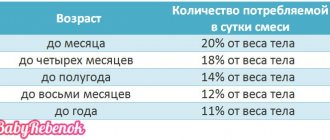Correct effective breastfeeding
A good attachment to the breast and effective sucking by the baby is observed with the following signs:
- Most of the areola, including the nipple, is in the baby's mouth.
- The breast is pulled into the mouth, forming a long "nipple", but the nipple itself takes up about a third of the space in the mouth. The areola is almost invisible.
- The baby sucks on the breast, not the nipple. His mouth is wide open, his chin is pressed to his mother's chest, his lips are turned outward, his head is slightly thrown back.
- The baby's tongue is directed forward towards the lower gum, folded at the edges to form a bed for the nipple. When a baby suckles, a wave travels along the tongue from front to back, pressing the nipple and part of the breast against the hard palate to squeeze milk from the breast into the mouth for swallowing.
- The baby actually uses suction mainly to draw breast tissue into the mouth and hold it there.
- When the baby is well attached and properly attached to the breast, his mouth and tongue do not rub or injure the skin of the nipple and areola.
- The baby is comfortable, and the feeding process is pleasant for the mother. She doesn't feel pain.
If the baby is well attached to the breast, then he will be able to suck milk effectively. The following signs will indicate this: the baby makes slow, visible sucking movements. Swallowing sounds are heard approximately once per second. Sometimes the baby pauses for a few seconds, allowing the milk to fill his mouth. When the baby starts sucking again, he can do it a little faster at first, stimulating the supply of milk, and then switching to slow, deep sucking movements. The baby's cheeks remain rounded during feeding. Toward the end of feeding, sucking usually slows down, movements become less frequent and are accompanied by longer pauses. It is important that the baby continues to suckle, since at this time the “hind” milk, rich in fats, arrives. When the baby is full, he spontaneously releases the breast. The nipple may look stretched at this time, but it returns to its original shape in a few seconds.
Prevention of breast mastitis
To prevent breast mastitis
You should follow the rules of personal hygiene, prevent stagnation of milk and avoid cracks and abrasions on the nipples. Please note that it is necessary to wash the nipple before and after feeding. If we talk about the treatment of cracked breasts, then sea buckthorn oil, white streptocide and starch will help you here.
It is also necessary to remember special rules when breastfeeding
:
- periodically change the position of the child so that the pressure on different parts of the nipple is uniform;
- if after feeding the baby does not let go of the nipple, lightly pinch the baby’s nose so that he pushes the nipple out;
- After feeding, it is recommended to dry the nipple. To do this, he must stay in the air for another 2-3 minutes;
- You should express all remaining milk without touching the nipple with your hands (it is better to use a breast pump);
- change your underwear daily, boil and iron your bra thoroughly.
Incorrect and ineffective breastfeeding by the baby
Signs that your baby is not properly attached to the breast and is not sucking correctly:
- The baby's mouth only contains the nipple, not the breast tissue. In this case, the areola is clearly visible, and the child’s mouth is not open wide. The lips are rolled inward or extended into a tube.
- The baby's tongue is not extended and cannot reach the breast to squeeze milk out of it.
- The feeding process is uncomfortable or painful for the mother, causing pain in the nipples and their damage (cracks).
A baby who is poorly attached to the breast will most likely not suckle effectively. He may suck quickly, but will swallow very rarely and his cheeks will retract inwards. When the baby stops sucking and releases the breast, the nipple may remain flattened for a long time or have signs of compression.
When a baby sucks ineffectively, the milk does not flow well into the nipple. As a result, due to impaired milk flow, blockages of the milk ducts and mastitis can occur. If a baby doesn't consume enough milk, it will lead to poor weight gain. Also in such cases, the baby may be weaned. Or, on the contrary, the baby will suck for too long and want to eat too often, which will lead to reflex stimulation of the production of excess milk.
The reasons for ineffective attachment and breastfeeding may include:
- The use of a feeding bottle and pacifiers, which change the child’s motor sucking patterns to incorrect ones: the child begins to suck not the breast, but the nipple - as well as the pacifier.
- Functional difficulties such as flat and inverted nipples, or a very small or weak infant.
However, the most important reasons are the inexperience of the mother and the lack of qualified assistance from the medical workers who visit her. Many mothers need qualified help from a lactation consultant in the first days of feeding to ensure that the baby attaches well and suckles at the breast.
Behavior Changes
Category: Articles, Articles by breastfeeding consultants.
Sometimes a woman may notice that the baby is constantly “hanging” on her chest. It is difficult to imagine how such feeding can continue: a year, two or even longer. But this behavior of the child will not last too long. Babies grow very quickly, very soon they begin to roll over, crawl, walk and even run. Children have a whole list of interests, in addition to breasts and mothers
Immediately after birth, the baby needs constant contact with his mother. Breastfeeding allows you to give your baby maximum contact with less energy. When feeding, the baby will eat and drink and, thanks to the special composition of breast milk, will forget about all the pain and hardships.
What behavioral changes can we see in a child around the year?
- the child trusts the world around him and strives to study it. If you give your child enough stimuli, breastfeeding “out of boredom” will decrease.
- calming applications are reserved only for cases of serious fright or painful shock.
- the amount of complementary foods increases significantly and gradually becomes the main food, and breast milk turns into additional food.
- The baby is big enough and can suckle more effectively, which means he gets the required amount of milk faster.
Against the background of all these changes, the number of breastfeeding also changes.
Usually, by the age of one year, babies have already formed an approximate daily routine, and they sleep 3-4 times a day. This is 2-3 daytime naps and one night nap. But every time he falls asleep and wakes up, the baby still expects to be put to the breast, as this helps him relax and feel safe. Babies may also ask for the breast one to three times at night and in stressful situations. In addition, the baby may latch on when he misses his mother or when he needs physical contact and mother’s attention.
Some babies after a year may ask for breastfeeding very often during the day. This may be due to the baby’s health and teething. In such cases, application serves as a method of calming, relieving stress, and a way to relieve pain.
There are other reasons for frequent, short or, conversely, long-term breastfeeding. Grown-up babies are already mature enough to communicate with their mother in a different way: reading books, outdoor games, etc. However, it is the mother’s task to introduce their use into communication with the child. If the range of ways to interact with the mother does not expand, the child may continue to choose the usual one - breastfeeding.
Sometimes women note that after a year there are more night feedings, and the baby nurses almost all night. Of course, such feeding is very exhausting and this is a reason to think about ending breastfeeding.
What could be the reason for frequent breastfeeding at night?
- First of all, you should check if the child has any health problems. You can visit a pediatrician, take a general blood test and check your hemoglobin. If hemoglobin is low, the doctor prescribes treatment. Teething can also cause frequent awakenings.
- If everything is in order with the tests, you can look at the baby’s nutrition with adult food. If a child does not eat enough during the day, he will get the required amount of nutrients at night. This does not mean at all that you need to urgently increase children's portions and try to feed the child more and more satisfyingly. After all, if complementary foods are introduced, but the child has no interest in food or the chewing skill has not been formed, excessive persistence in this matter can cause him to refuse food even more. You can discuss your specific situation with a lactation consultant.
- A large number of night feedings is sometimes associated with the topic of hygiene. By about a year or after a year, some babies do not want to write “for themselves.” They often wake up, experiencing discomfort (the desire to pee), out of habit, to eliminate the discomfort, they reach for the breast, receive it, pee, and sleep further until they wake up again from the same discomfort. In this case, seeing that the baby begins to spin in his sleep, you can offer him the breast and sit him over a potty or basin. After peeing, the baby almost immediately falls asleep and can sleep peacefully until the next time.
- Another reason may be that the child is overexcited during the day. The breast is an excellent means of calming, and if there is an excess of emotions during the day or missed dreams, the baby may be more often attached to the breast at night.
If you find and eliminate the reason why your baby began to nurse more often at night, he can enter his usual rhythm.
Around the age of one year, the child is able to understand and gradually accept new rules for himself. Several rules can be introduced into the topic of breastfeeding to make it more comfortable for the mother.
Some women prefer to stop feeding on the street, car or public transport by the age of one year. Others pay attention to behavior with the breast, not allowing latching on both breasts, pinching oneself, twisting the nipple on the other breast, or undressing the mother. Still others may begin to teach the baby to ask for the breast quietly “in secret.”
These rules are very individual. And each woman regulates this at her own discretion, based on her personal comfort and relationship with the baby.
The article can be briefly summarized as follows: a child a little over a year old still really needs to be latched to the breast and mother’s milk. However, we are no longer talking about feeding on demand like a newborn. Rather, it looks like feeding by agreement, when it is comfortable for both mother and baby. The reduction in breastfeeding around the year occurs not due to restrictions, but due to the expansion of the child’s opportunities to interact with his mother and satisfy his needs in other ways.
Authors: Ekaterina Semibratova, breastfeeding consultant, member of the NGO KGV “Dairy Help” (Ust-Kamenogorsk). Ekaterina Klassen, breastfeeding consultant, member of the NGO KGV “Dairy Help” (Karaganda).
First published: https://detki.kz/article/kormlenie-grudyu-posle-goda
Share
Comments
Call a breastfeeding specialist to your home
At the group's children's medical centers, we know that the most convenient place for breastfeeding consultations is your own cozy home:
- A specialist will come to you at a convenient time. You don't have to go to the clinic and wait in line. Consultations can also be held directly in the maternity hospital (if visits are permissible) or in a medical center.
- A familiar home environment makes consultation easier for both mother and child.
- At home, the consultant will be able to devote more time to both the child and the parents.
- The consultant is always a phone call away: day and night (at night you can call the contact center or write to the consultant, the consultant will answer as soon as possible), on weekdays and on weekends.
- Support from a specialist is not one-time consultations, but accompaniment: the consultant will visit the mother and baby again, if necessary, after 2-4 weeks to check how feeding is going and the baby’s weight gain.
In addition to calling a breastfeeding specialist to your home, you can call doctors of the main specialties: pediatrician, surgeon, allergist, urologist, pulmonologist, hematologist, dermatologist, ophthalmologist, ENT doctor, orthopedist, gastroenterologist and osteopath. You can also take tests, perform physiotherapy and massage at home. Infant swimming consultants can advise you at home and conduct a master class.
Find out about the special offer “Comprehensive examination at home”: the convenience of this program is that you can choose from a list of pediatric doctors exactly those specialists that your child needs and an individual set of medical services with a 20% discount!
Advantages of calling Virilis Group specialists to your home
- Travel to any area of the city and region without restrictions.
- No insurance, registration or citizenship is required to receive medical care.
- Providing assistance to children of any age.
- Experience in responsible treatment of children in St. Petersburg since 1991.
- 6 own children's medical centers with 650 specialists in 49 specialties.
- Possibility of diagnostics and continuation of treatment in our clinics.
- Coordination with other doctors of the VIRILIS Group of Companies clinics: we are a single team, and not individual doctors from a “mobile” clinic.
- 24/7 contact center.
- Issuance of official medical certificates and documents.
- Possibility of purchasing a package of a comprehensive medical program for a child, including the “Emergency Care” and “Comprehensive Examination at Home” packages.
- Special medical programs for newborns and infants.









